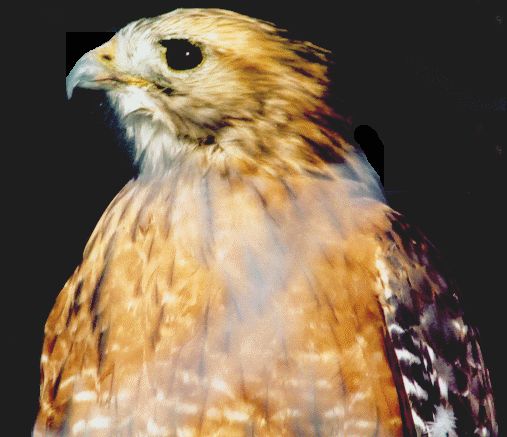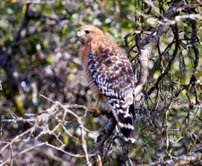
Raptor Identification - Red-shouldered Hawk

If you have any photos of Red-shouldered Hawks that you would like to contribute, please e-mail them to us with a caption and the photographer's name (but be aware that we must be selective of which photos we include because of space limitations for our website). |
Click on each photo for a description and a bigger picture
 |
 |
 |
 |
 |
 |
||
 |
 |
||
 |
The following article about Red-shouldered Hawks was reproduced (with modifications) from the May 2001 issue of CPF's Talon Tales. The article was written by Natalie Helferty.
The breeding range of the red-shouldered hawk extends across eastern North America, from the Great Lakes-St Lawrence forest ecozone down to Florida and eastern Texas. A separate population exists on the west coast throughout California. The eastern population migrates with other raptors, generally avoiding travel over large bodies of water. Most overwinter in the southern states, though some reach central Mexico and a few remain as far north as the southern Great Lakes. The habitat niche of the red-shouldered hawk is large deciduous or mixed forests, specifically bottomland forests (swamps, floodplains) or upland forests with nearby wetlands or streams. This habitat association is mainly due to its diet, which comprises a larger proportion of herptiles than any other raptor in North America. Roughly half of its prey consists of amphibians and reptiles such as the leopard frog and garter snake, while the remainder of the diet is mostly wetland mammals such as the star-nosed mole. The red-shouldered hawk is a sensitive forest species in that it nests in large tracts of mature forest with home ranges in the order of 250 hectares per breeding pair. They have been known to nest in small forest blocks of 4 hectares, but readily abandon these sites when disturbed. Mature forests of 70+ year old trees, with at least 70% canopy cover, are their preferred habitat for nesting. Red-shouldered hawks usually nest in the main crotch of large deciduous trees which have a three-pronged fork of sturdy branches to support their bulky stick nest. American beech is the tree most commonly used for nesting in southern Ontario, and nests are usually located 8 to 24 metres (20 to 60 feet) above the ground. Finger-thick sticks, especially from conifers such as hemlock or balsam fir, form the foundation of the nest, and are lined with finer material like leaves and conifer sprigs, which are replenished from incubation onward. Nests are often reused every year and can become quite large and bulky; some hawks have been known to nest for twenty years in the same tree. Several ‘satellite’ nests are often built in trees within a few hundred metres of the main nest, and are sometimes used in subsequent years, providing some flexibility in nest site selection within a forest block.
The red-shouldered hawk was once the most abundant hawk in eastern North America, but is now the least common. It is ranked as a ‘species of concern’ in Canada and as ‘vulnerable’ in Ontario. Current numbers are very low, but populations have remained relatively stable over the last decade or two. The primary reason for the red-shouldered hawk’s precipitous decline over the last century was the loss and degradation of habitat. As forests were cleared for agriculture, the availability of suitable breeding territories declined, and in the remaining forests the red-shouldered hawk was subject to increased competition from the great horned owl and the red-tailed hawk, which is now the most common hawk in many regions. Increased logging, especially the practice of ‘high-grading’ (selectively cutting the largest trees) contributed further to the rapid decline of the species from the 1930s to the 1980s. Some improvement in forestry practices, especially on Crown land on the Canadian Shield, as well as protection of nest trees, has resulted in a small increase of red-shouldered hawk numbers in central Ontario. Until natural deciduous forest cover has reached maturity though, numbers can be expected to remain below historic levels. The continued expansion of urban sprawl into some of the few remaining high quality breeding areas constitutes another threat to the population in southern Ontario and beyond. The protection and expansion of our deciduous forests is the only way to ensure the stabilization and eventual recovery of the red-shouldered hawk population. Article by Natalie Helferty, co-author of the 2001 draft report to the Ontario Ministry of Natural Resources, "Management and Recovery Strategy of Red-shouldered Hawk in Aurora District". |
© Canadian Peregrine Foundation